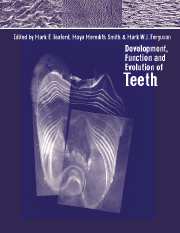Book contents
- Frontmatter
- Contents
- List of contributors
- Acknowledgements
- Part one Genes, molecules and tooth initiation
- Part two Tooth tissues: development and evolution
- 5 Evolutionary origins of dentine in the fossil record of early vertebrates: diversity, development and function
- 6 Pulpo-dentinal interactions in development and repair of dentine
- 7 Prismless enamel in amniotes: terminology, function, and evolution
- 8 Two different strategies in enamel differentiation: Marsupialia versus Eutheria
- 9 Incremental markings in enamel and dentine: what they can tell us about the way teeth grow
- Part three Evolution of tooth shape and dentition
- Part four Macrostructure and function
- Index
6 - Pulpo-dentinal interactions in development and repair of dentine
Published online by Cambridge University Press: 11 September 2009
- Frontmatter
- Contents
- List of contributors
- Acknowledgements
- Part one Genes, molecules and tooth initiation
- Part two Tooth tissues: development and evolution
- 5 Evolutionary origins of dentine in the fossil record of early vertebrates: diversity, development and function
- 6 Pulpo-dentinal interactions in development and repair of dentine
- 7 Prismless enamel in amniotes: terminology, function, and evolution
- 8 Two different strategies in enamel differentiation: Marsupialia versus Eutheria
- 9 Incremental markings in enamel and dentine: what they can tell us about the way teeth grow
- Part three Evolution of tooth shape and dentition
- Part four Macrostructure and function
- Index
Summary
Introduction
Dentine and pulp are developmentally and functionally related to such an extent that they should be considered together as a complex. This interrelationship becomes of critical importance both during physiological development and maintenance of the tissues and also, in tissue repair after injury. As our understanding of the molecular and cellular events during tissue formation and repair expands, it is becoming increasingly apparent that many of the events of tissue formation may be mirrored during repair after injury of the tissue (Lesot et al., 1993, 1994). Thus, elucidation of these events becomes a prerequisite for development of new, effective treatment modalities to effect tissue repair in the dentine-pulp complex after injury.
Pulp-dentine complex: from development to repair
The early stages of tooth initiation give rise to the enamel organ and dental papilla of the developing tooth germ. As development proceeds, epithelial-mesenchymal interactions between tissue compartments control tooth morphogenesis and cytodifferentiation (Kollar, 1983; Ruch, 1987; Slavkin, 1990; Thesleff et al., 1991). A number of aspects of these processes during the earlier stages of tooth development are dealt with in the first section of this volume (e.g. Chapter 3). These processes lead to a basement membrane being interposed between the inner dental epithelium and mesenchymal cells of the dental papilla that will give rise to the odontoblasts responsible for secretion of dentine. This basement membrane has been hypothesized to act as a mediator of the epithelial-mesenchymal interactions which control odontoblast differentiation (Thesleff, 1978; Ruch et al., 1982; Ruch, 1987; Thesleff and Vaahtokari, 1992).
- Type
- Chapter
- Information
- Development, Function and Evolution of Teeth , pp. 82 - 91Publisher: Cambridge University PressPrint publication year: 2000
- 3
- Cited by



